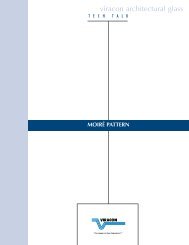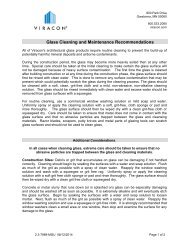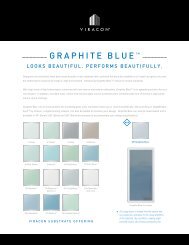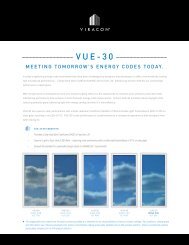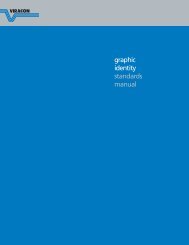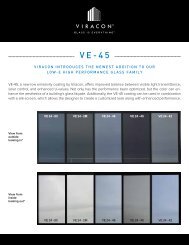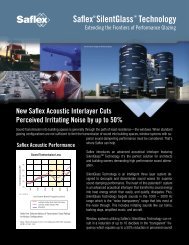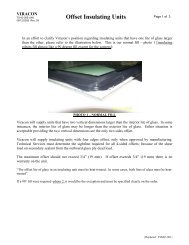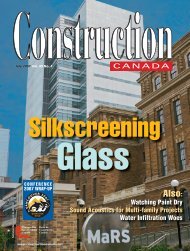2 0 1 3 P R O D U C T G U I D E VIRACON PRODUCT GUIDE 2013 ...
2 0 1 3 P R O D U C T G U I D E VIRACON PRODUCT GUIDE 2013 ...
2 0 1 3 P R O D U C T G U I D E VIRACON PRODUCT GUIDE 2013 ...
You also want an ePaper? Increase the reach of your titles
YUMPU automatically turns print PDFs into web optimized ePapers that Google loves.
HEAT TREATment<br />
Heat Treatment Definitions<br />
Heat-treated glass is a term used to describe glass that has been processed through a tempering furnace to alter its strength<br />
characteristics. The process is done in order to provide greater resistance to thermal and mechanical stresses and achieve specific<br />
break patterns for safety glazing applications as compared to annealed glass.<br />
ANNEALED(AN)<br />
Raw glass that has not been heat treated is annealed glass.<br />
In a specification, the designation for annealed glass is AN.<br />
HEAT STRENGTHENED(HS)<br />
Heat-strengthened glass is twice as strong as annealed glass of the same thickness, size and type. If broken, heatstrengthened<br />
glass will break into large shards similar to annealed glass.<br />
The surface compression of heat-strengthened glass with thicknesses of 1/4” (6mm) and less is 4,000 - 7,000 psi. Surface<br />
compression for 5/16” (8mm) and 3/8” (10mm) heat-strengthened glass is 5,000 - 8,000 psi. (Because of reader repeatability<br />
and instrument tolerances, Viracon’s tolerance for heat-strengthened glass surface compression is +/- 1,000 psi.)<br />
While improving the strength and resistance to thermal shock and stress, heat-strengthened glass does not meet safety<br />
glazing requirements as outlined by the American National Standards Institute (ANSI) Z97.1 or the federal safety standard<br />
Consumer Products Safety Commission (CPSC) 16 CFR 1201, and therefore should not be used in these situations.<br />
In a specification, the designation for heat strengthened glass is HS.<br />
FULLY TEMPERED(FT)<br />
Glass with fully tempered surfaces is typically four times stronger than annealed glass and two times as strong as heatstrengthened<br />
glass of the same thickness, size and type. In the event that fully tempered glass is broken, it will break into<br />
fairly small pieces, reducing the chance for injury. In doing so, the small glass shards make it more likely that the glass will<br />
become separated from the opening. The minimum surface compression for fully-tempered glass is 10,000 psi. In addition, it<br />
complies with the safety glazing requirements as outlined by the American National Standards Institute (ANSI) Z97.1 and the<br />
federal safety standard Consumer Products Safety Commission (CPSC) 16 CFR 1201.<br />
In a specification, the designation for fully tempered glass is commonly abbreviated as FT.<br />
HEAT SOAKING<br />
Fully tempered glass may break without warning due to the expansion of nickel sulfide inclusions (NiS) present within float<br />
glass. To avoid the risk of spontaneous breakage in fully tempered glass, a common practice is to avoid the use of tempered<br />
glass whenever possible. Although the incidence of tempered glass breakage due to these inclusions is rare, greater publicity<br />
of their occurrence has resulted in an increased awareness of this phenomenon. In fact, limiting the use of tempered glass in<br />
commercial building applications has become the recommendation of a number of glass suppliers, including Viracon. In some<br />
situations however, tempered glass is required to meet safety glazing requirements or for added strength. In these cases,<br />
Viracon can perform a heat soak test to provide the added assurance that significant spontaneous breakage will not occur.<br />
For more information, refer to our technical document Heat Soak Testing on our website viracon.com.<br />
<strong>VIRACON</strong> // COMPONENTS & ENHANCEMENTS 031



